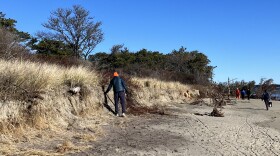Climate change is happening. In Connecticut, it looks like hotter summers and flooding, according to experts at the Connecticut Institute for Resilience & Climate Adaptation, or CIRCA, located at the University of Connecticut.
But heat doesn’t affect everyone equally. Dr. Yaprak Onat, the assistant director of research at CIRCA, said the question now is how the effects of rising temperatures can be mitigated equitably.
“It is happening no matter what, so we need to plan for it,” Onat said. “Otherwise, there's a lot to lose, especially [in] disadvantaged communities.”
Cities experience some of the worst heat exposure, according to data on the Climate Change Vulnerability Index. Onat and her colleagues at CIRCA gathered data from satellites, demographics and municipalities to measure both heat and populations’ ability to handle that heat. CIRCA started with Fairfield and New Haven counties and plans to gather the data for the rest of the state later this year.
VIEW: CIRCA's interactive Climate Change Vulnerability Index Map
Cities are hotter because of air quality, dense buildings and impervious surfaces, like pavement, Onat said. Cities also lack something she calls “breathing pockets,” like shade or green spaces.
“If you don't come up with solutions to cool down regions and create these breathing pockets, then it’s going to be more challenging for the people,” Onat said, considering those who work outside or don’t have a way to get to the beach.
She expects emergency room visits and mortality rates to rise due to extreme heat, especially in these vulnerable groups.

Exposure is just one measure of climate vulnerability: The map considers environmental conditions, how sensitive populations are to heat and their ability to bounce back from hot days. Older adults and people with asthma are more sensitive, she said. Low-income people and those without health insurance will struggle to afford an air conditioner or the medical costs of heat exhaustion, Onat said.
“We need to right now define strategies to cope and reduce. So what our institute is looking for is what we can do,” she said.
With this data, CIRCA can focus resources on the most vulnerable populations in the hottest places. It’s working with engineers and planners to create solutions for seven neighborhoods in Fairfield and New Haven counties.
Onat said potential solutions might look like a cooling center or more sophisticated options, all with the intent of making people’s lives more bearable during climate change.





